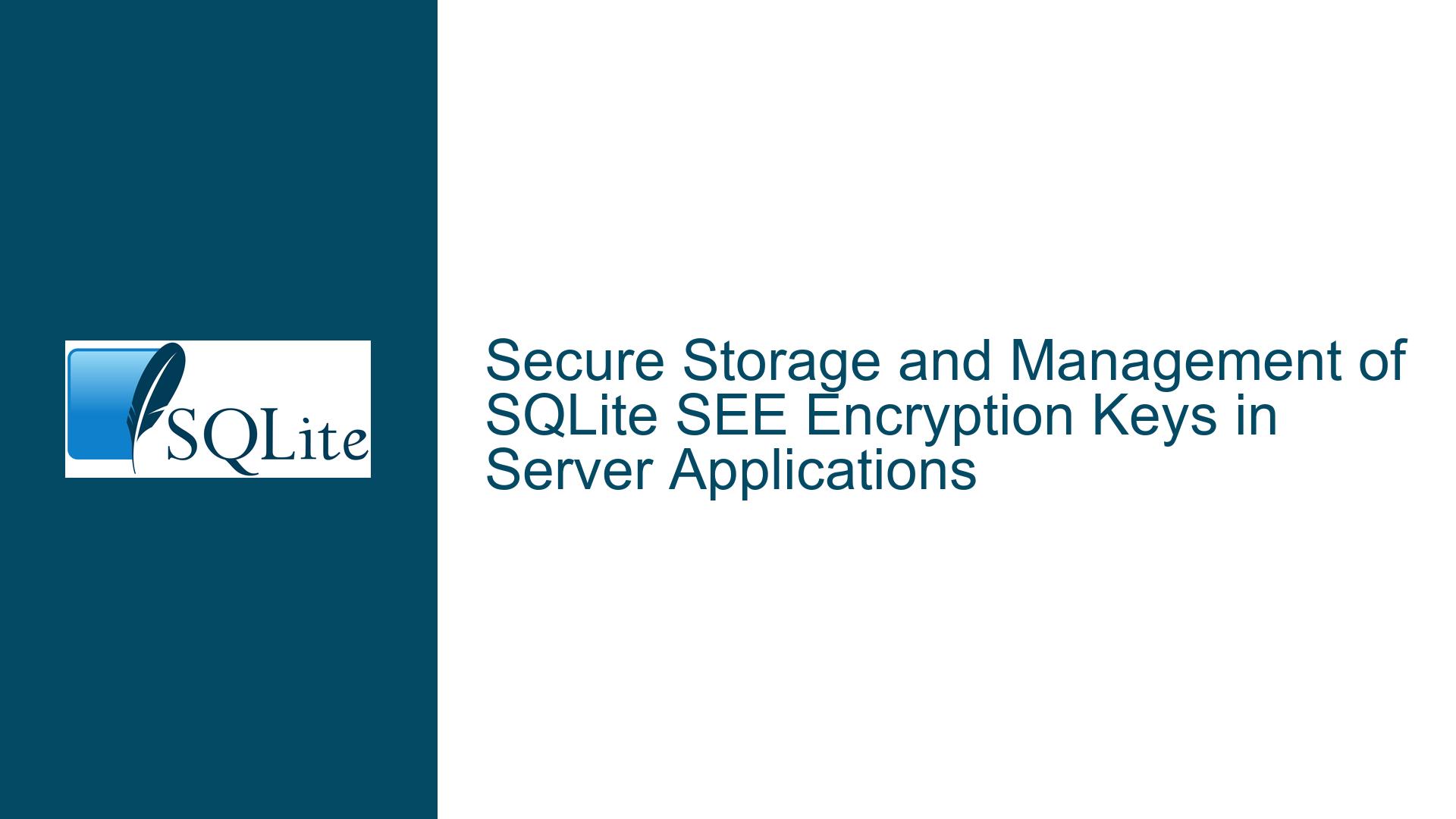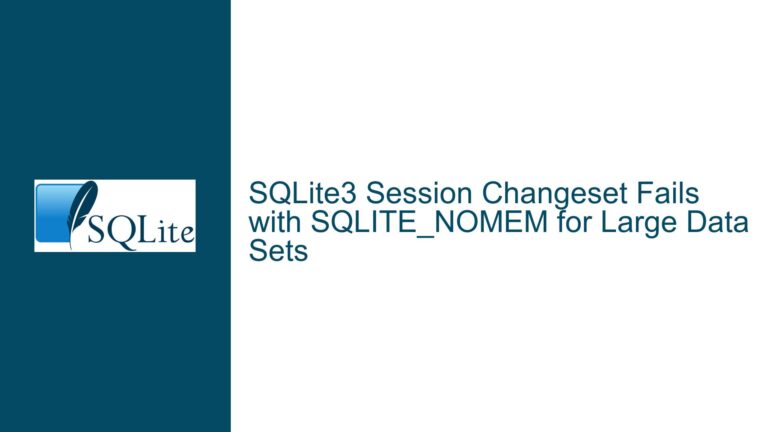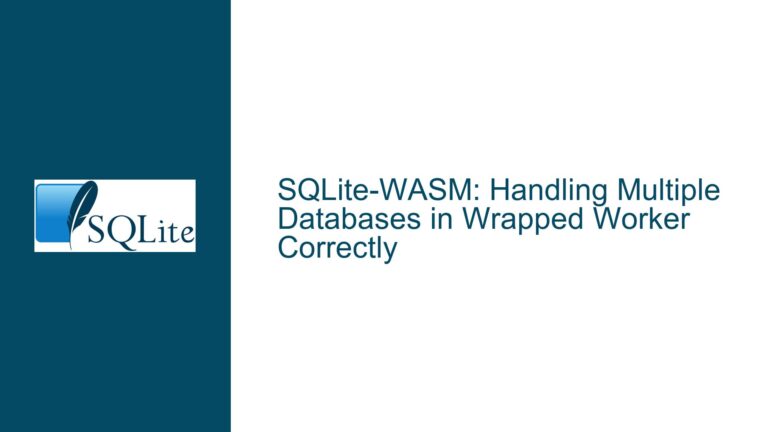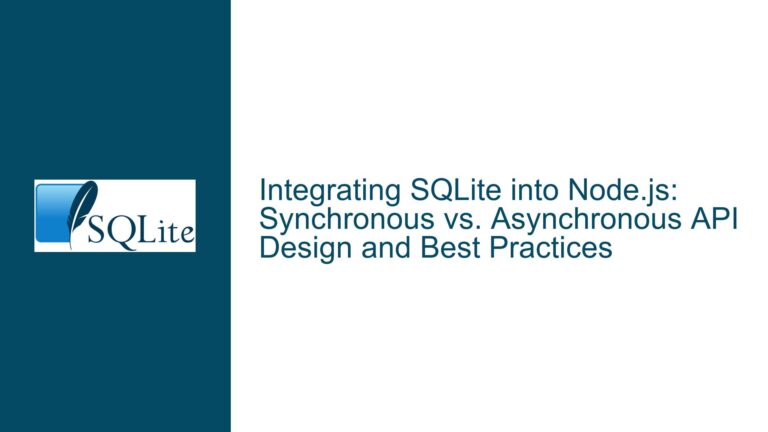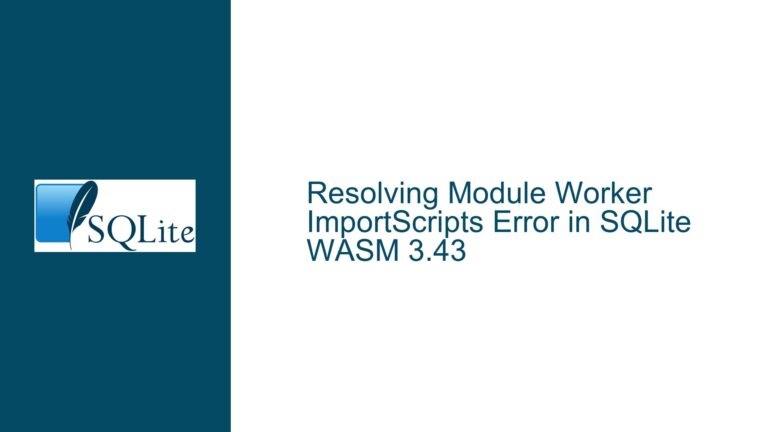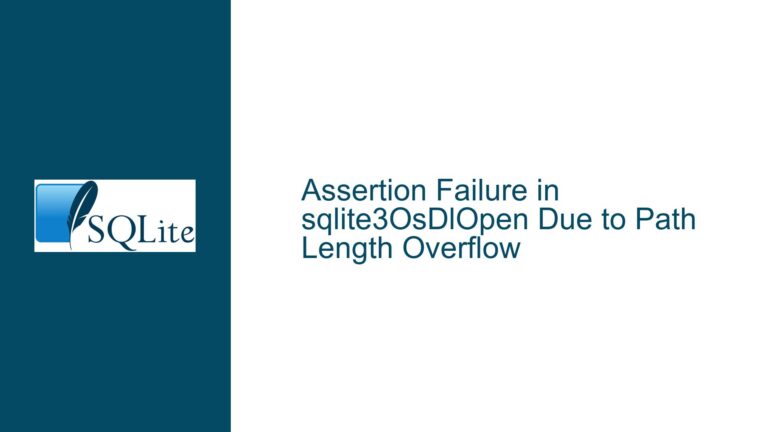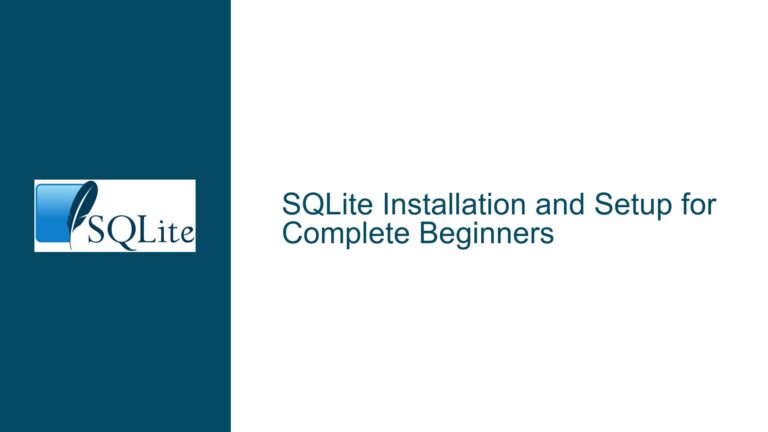Secure Storage and Management of SQLite SEE Encryption Keys in Server Applications
SQLite SEE Encryption Key Management in Standalone Server Applications
When deploying a server application that utilizes SQLite with the SQLite Encryption Extension (SEE) for database encryption, one of the most critical challenges is the secure storage and management of the encryption key. Unlike client applications where user interaction can facilitate key input, server applications often operate autonomously, requiring a robust and secure method to handle encryption keys without compromising security. This post delves into the intricacies of managing SQLite SEE encryption keys in standalone server applications, exploring the underlying issues, potential causes, and comprehensive solutions to ensure both security and functionality.
SQLite SEE Encryption Key Storage Challenges in Autonomous Environments
The primary challenge in using SQLite SEE in a server application lies in the secure storage and retrieval of the encryption key. SQLite SEE requires an encryption key to encrypt and decrypt the database. In a typical client application, the key might be entered by the user at runtime, but in a server environment, this approach is impractical due to the lack of user interaction. The key must be stored securely yet remain accessible to the server application to perform database operations.
The security of the encryption key is paramount. If the key is compromised, the entire database’s security is at risk. Therefore, the key must be stored in a manner that prevents unauthorized access while still allowing the server application to retrieve it when needed. This dual requirement of security and accessibility presents a significant challenge, especially in environments where the server application runs with elevated privileges or in shared hosting scenarios.
Moreover, the key management strategy must account for various operational scenarios, such as server restarts, application updates, and potential key rotation policies. Each of these scenarios introduces additional complexity, as the key must be securely stored and retrieved without manual intervention. The challenge is further compounded by the need to ensure that the key storage mechanism itself is not vulnerable to attacks, such as memory scraping or file system breaches.
Potential Vulnerabilities in Key Storage Mechanisms
Several potential vulnerabilities can arise from improper key storage mechanisms in server applications using SQLite SEE. One common approach is to store the encryption key in a configuration file or environment variable. While this method is straightforward, it is inherently insecure. Configuration files and environment variables are often accessible to anyone with file system or shell access, making them easy targets for attackers. Additionally, these storage methods do not provide any form of encryption or access control, further increasing the risk of key exposure.
Another approach is to hardcode the encryption key within the application’s source code. This method is equally insecure, as it exposes the key to anyone with access to the source code or the compiled binary. Reverse engineering techniques can easily extract hardcoded keys, rendering the encryption useless. Furthermore, hardcoding keys complicates key rotation, as updating the key requires modifying and redeploying the application.
A more sophisticated but still flawed approach involves using external key management services (KMS) or hardware security modules (HSM). While these solutions offer enhanced security, they introduce additional complexity and potential points of failure. For instance, if the KMS or HSM becomes unavailable, the server application may be unable to access the encryption key, leading to service disruptions. Additionally, integrating these services with SQLite SEE may require custom development, increasing the risk of implementation errors.
Implementing Secure Key Storage with Integrated Access Controls
To address the challenges and vulnerabilities associated with SQLite SEE encryption key management in server applications, a comprehensive approach that combines secure storage mechanisms with integrated access controls is essential. One effective strategy is to use a combination of encrypted key storage and runtime key retrieval mechanisms.
Encrypted key storage involves storing the encryption key in an encrypted form, using a master key that is securely managed by the server application. The master key can be derived from a combination of factors, such as a hardware-based unique identifier, a securely stored configuration value, or a key management service. By encrypting the SQLite SEE encryption key with a master key, the risk of key exposure is significantly reduced, as the encrypted key is useless without the master key.
Runtime key retrieval mechanisms ensure that the SQLite SEE encryption key is only decrypted and available in memory when needed. This approach minimizes the window of opportunity for attackers to capture the key. The key can be decrypted at application startup or when a database connection is established and immediately discarded after use. This transient storage of the key in memory reduces the risk of key exposure through memory scraping or other runtime attacks.
Access controls play a crucial role in securing the key storage and retrieval process. The server application should run with the minimum necessary privileges, limiting access to the key storage location and the master key. Additionally, the application should implement strict access controls on the key storage files, ensuring that only authorized processes can read or modify them. This can be achieved through file system permissions, access control lists (ACLs), or operating system-level security features.
To further enhance security, the server application can implement key rotation policies, periodically changing the SQLite SEE encryption key and updating the encrypted key storage. Key rotation reduces the risk of key compromise by limiting the time window during which a key is valid. The application should also monitor and log key access attempts, enabling the detection of unauthorized access or suspicious activities.
In summary, managing SQLite SEE encryption keys in standalone server applications requires a multi-layered approach that combines secure storage, runtime key retrieval, and integrated access controls. By implementing these strategies, server applications can ensure the security of their encrypted databases while maintaining operational efficiency and resilience against potential attacks. The following sections provide detailed steps and solutions to achieve this goal.
Secure Storage Solutions for SQLite SEE Encryption Keys
Encrypted Key Storage with Master Key Derivation
One of the most effective methods for securely storing SQLite SEE encryption keys is to use encrypted key storage with master key derivation. This approach involves encrypting the SQLite SEE encryption key using a master key, which is itself securely managed by the server application. The master key can be derived from various sources, such as a hardware-based unique identifier, a securely stored configuration value, or a key management service.
To implement this solution, the server application should first generate a strong master key. This key should be derived from a combination of factors that are unique to the server environment, such as the server’s hardware UUID, a securely stored configuration value, or a key management service. The master key should be stored in a secure location, such as a hardware security module (HSM) or a key management service, and should only be accessible to the server application.
Once the master key is generated and securely stored, the server application can use it to encrypt the SQLite SEE encryption key. The encrypted key can then be stored in a configuration file or environment variable, as it is now protected by the master key. When the server application needs to access the SQLite SEE encryption key, it can retrieve the master key, decrypt the encrypted key, and use it to open the database.
This approach provides a high level of security, as the SQLite SEE encryption key is never stored in plaintext. Even if an attacker gains access to the encrypted key, they would need the master key to decrypt it, which is securely managed by the server application. Additionally, this method allows for easy key rotation, as the master key can be updated without changing the SQLite SEE encryption key.
Runtime Key Retrieval and Transient Storage
To further enhance security, the server application should implement runtime key retrieval and transient storage mechanisms. This approach ensures that the SQLite SEE encryption key is only decrypted and available in memory when needed, minimizing the risk of key exposure.
When the server application starts or when a database connection is established, it should retrieve the master key and use it to decrypt the SQLite SEE encryption key. The decrypted key should be stored in memory only for the duration of the database operation and immediately discarded afterward. This transient storage of the key in memory reduces the risk of key exposure through memory scraping or other runtime attacks.
To implement this solution, the server application should use secure memory management techniques, such as zeroing out memory after use, to ensure that the decrypted key is not left in memory after the database operation is complete. Additionally, the application should minimize the use of the decrypted key, only decrypting it when necessary and immediately discarding it after use.
This approach provides an additional layer of security, as the SQLite SEE encryption key is only available in memory for a short period of time. Even if an attacker gains access to the server’s memory, they would have a limited window of opportunity to capture the key.
Integrated Access Controls and Monitoring
Access controls play a crucial role in securing the key storage and retrieval process. The server application should run with the minimum necessary privileges, limiting access to the key storage location and the master key. Additionally, the application should implement strict access controls on the key storage files, ensuring that only authorized processes can read or modify them.
To implement this solution, the server application should use file system permissions, access control lists (ACLs), or operating system-level security features to restrict access to the key storage files. Only the server application should have read access to the encrypted key storage, and only authorized administrators should have write access to the master key storage.
Additionally, the server application should implement monitoring and logging of key access attempts. This includes logging successful and failed attempts to access the key storage files, as well as any changes to the master key. These logs should be regularly reviewed and analyzed to detect unauthorized access or suspicious activities.
By implementing these access controls and monitoring mechanisms, the server application can ensure that the SQLite SEE encryption key is only accessed by authorized processes and that any unauthorized access attempts are detected and responded to promptly.
Key Rotation and Operational Resilience
Implementing Key Rotation Policies
Key rotation is an essential aspect of maintaining the security of encrypted databases. By periodically changing the SQLite SEE encryption key, the server application can reduce the risk of key compromise and limit the potential damage if a key is exposed.
To implement key rotation, the server application should periodically generate a new SQLite SEE encryption key and update the encrypted key storage. The new key should be encrypted using the master key and stored in the same secure location as the previous key. The server application should then update the database to use the new key, ensuring that all future database operations are performed with the new key.
Key rotation should be performed at regular intervals, such as every 90 days, or in response to specific events, such as a security breach or a change in the server environment. The server application should also maintain a history of previous keys, allowing for the decryption of older database entries if necessary.
Ensuring Operational Resilience
Operational resilience is critical in ensuring that the server application can continue to operate securely and efficiently, even in the face of potential key management challenges. This includes ensuring that the server application can handle key rotation, key loss, and key recovery scenarios without disrupting service.
To ensure operational resilience, the server application should implement robust key recovery mechanisms. This includes maintaining secure backups of the master key and the encrypted key storage, as well as implementing procedures for recovering from key loss or corruption. The server application should also be able to detect and respond to key management issues, such as unauthorized key access or key rotation failures.
Additionally, the server application should be designed to handle key management failures gracefully. This includes implementing fallback mechanisms, such as using a secondary key management service or hardware security module, to ensure that the server application can continue to operate even if the primary key management solution becomes unavailable.
By implementing these key rotation and operational resilience strategies, the server application can ensure the long-term security and reliability of its encrypted databases, even in the face of evolving security threats and operational challenges.
Conclusion
Managing SQLite SEE encryption keys in standalone server applications is a complex but essential task that requires a comprehensive and multi-layered approach. By implementing secure storage solutions, runtime key retrieval mechanisms, integrated access controls, and key rotation policies, server applications can ensure the security of their encrypted databases while maintaining operational efficiency and resilience. The strategies outlined in this post provide a detailed roadmap for achieving these goals, enabling server applications to securely manage SQLite SEE encryption keys in even the most challenging environments.
